For photographers, video editors, graphic designers, and other creative professionals, a monitor is more than just a display; it’s a digital canvas where their vision comes to life. The single most critical attribute of this canvas is color accuracy. Without it, hours of meticulous editing can be compromised, leading to work that appears inconsistent across different devices.
A color-accurate monitor ensures that the hues you see on screen are a faithful representation of the intended output, whether for print or digital media. This guide provides an in-depth, objective analysis of what constitutes a high-quality, color-accurate monitor. It details the essential technical aspects to consider and offers a clear examination of specific models tailored for creative workflows. This resource aims to be the definitive guide, answering not only your primary questions but also the secondary ones you might not have thought to ask.
Understanding Color Accuracy: A 2025 Snapshot
The market for professional monitors is dense with technical specifications. To make an informed decision, it’s crucial to understand the data points that truly matter for color-critical work. Below is a detailed comparison of the monitors discussed in this guide.
Detailed Comparison of Color-Critical Monitors
| Feature | ASUS ProArt PA278QV | SAMSUNG S27R650FDN | AOC U2790VQ | BenQ SW271C | ViewSonic VP2468 |
| Screen Size | 27 Inches | 27 Inches | 27 Inches | 27 Inches | 24 Inches |
| Resolution | 2560 x 1440 (QHD) | 1920 x 1080 (FHD) | 3840 x 2160 (4K UHD) | 3840 x 2160 (4K UHD) | 1920 x 1080 (FHD) |
| Panel Type | IPS | IPS | IPS | IPS | IPS |
| Refresh Rate | 75Hz | 75Hz | 60Hz | 60Hz | 60Hz |
| Color Gamut | 100% sRGB, 100% Rec. 709 | ~99% sRGB | ~99% sRGB, 90% NTSC | 99% Adobe RGB, 90% P3 | 100% sRGB, 100% Rec.709 |
| Color Accuracy | Calman Verified, ΔE < 2 | Not Specified | Not Specified | Calman/Pantone Validated, ΔE ≤ 2 | Factory Calibrated, ΔE < 2 |
| Peak Brightness | 350 cd/m² | 250 cd/m² | 350 cd/m² | 300 cd/m² | 250 cd/m² |
| Connectivity | DisplayPort 1.2, Mini DP, HDMI 1.4, Dual-link DVI-D, USB Hub | HDMI, DisplayPort, D-Sub, USB Hub | HDMI 2.0, HDMI 1.4, DisplayPort 1.2 | 2x HDMI 2.0, DP 1.4, USB-C (w/ 60W PD), USB Hub | HDMI, DisplayPort In/Out, Mini DP, USB Hub |
| Ergonomics | Height, Pivot, Swivel, Tilt | Height, Pivot, Swivel, Tilt | Tilt Only | Height, Pivot, Swivel, Tilt | Height, Pivot, Swivel, Tilt |
| Current Status | Widely Available | Available | Largely Discontinued | Widely Available | Widely Available |
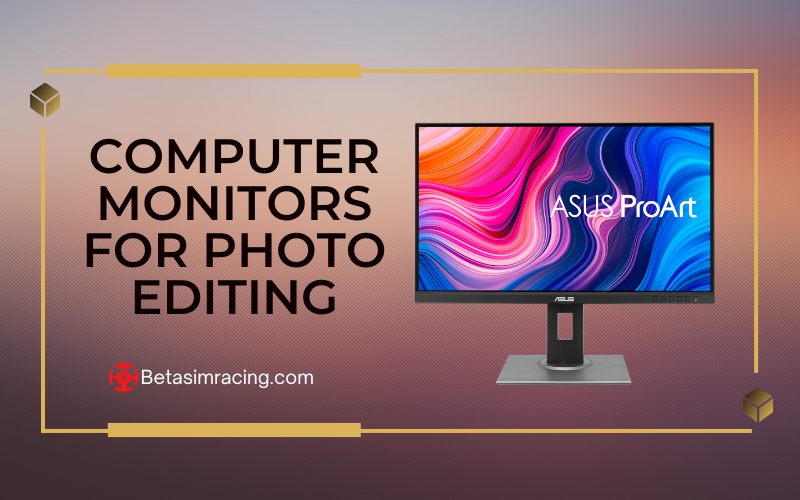
How to Choose a Color Accurate Monitor: An Expert’s Guide
Selecting the right monitor requires a foundational understanding of its core technologies. This section breaks down the most important factors.
Color Gamut Explained: sRGB vs. Adobe RGB vs. DCI-P3
A color gamut refers to the specific range of colors a device can reproduce. No display can show every color the human eye can perceive, so standardized gamuts are used.
- sRGB: The most common color space used for web content, most consumer applications, and general PC use. For web-based design work, 100% sRGB coverage is essential.
- Adobe RGB: A wider gamut than sRGB, particularly in the green and cyan ranges. It is the standard for professional photography and print production. Professionals in these fields should look for monitors with at least 98% Adobe RGB coverage.
- DCI-P3: A gamut commonly used in digital cinema and increasingly on premium consumer devices like smartphones and tablets. Video editors working on HDR content should prioritize high DCI-P3 coverage.
Understanding Delta E: The Measure of Color Accuracy
Delta E (dE) is a metric that quantifies the difference between a displayed color and the original, perfect color standard. A lower Delta E value indicates higher accuracy.
Key Takeaway: For professional creative work, a monitor should have a factory-calibrated Delta E value of less than 2 (ΔE < 2). This ensures that the inaccuracies are virtually imperceptible to the human eye.
Panel Technology: Why IPS is the Standard
There are several types of LCD panels, but for color-critical work, In-Plane Switching (IPS) panels are the undisputed industry standard.
- IPS (In-Plane Switching): Offers the best color reproduction and widest viewing angles. This means colors remain consistent even when viewed from off-center, which is crucial for collaborative work and maintaining accuracy.
- VA (Vertical Alignment): Known for superior contrast ratios, leading to deeper blacks. However, they can suffer from color shifting at wider viewing angles.
- TN (Twisted Nematic): An older technology that offers the fastest response times, making them popular for competitive gaming. They are not suitable for color-accurate work due to poor color reproduction and very narrow viewing angles.
For a deeper dive into display technologies, exploring concepts like the difference between an ultrawide vs regular monitor can provide additional context on how form factor interacts with panel performance.
Resolution and Screen Size: Finding Your Ideal Canvas
Resolution determines the clarity and detail of an image. It’s a balance between screen real estate and performance.
- Full HD (1920 x 1080): The baseline resolution. Suitable for 24-inch monitors but can appear pixelated on larger screens.
- QHD (2560 x 1440): Often considered the sweet spot for 27-inch monitors, offering a significant increase in detail over FHD without the high performance demands of 4K.
- 4K UHD (3840 x 2160): Provides exceptional sharpness and detail, ideal for editing high-resolution photos and 4K video. Keep in mind that running a 4K display requires a more powerful graphics card, and choosing from the best monitors for RTX 3070 and RTX 3080 can be a good starting point.
Brightness and Contrast Ratio
Brightness, measured in nits (or cd/m²), determines how well a screen can be seen in brightly lit environments. A typical professional monitor offers 250-350 nits. Contrast ratio measures the difference between the brightest white and darkest black. A higher ratio (e.g., 1000:1 or better) results in deeper blacks and more “pop” in the image.
The Role of Hardware and Software Calibration
While factory calibration is a great starting point, serious professionals must perform regular calibration to account for changes in the monitor’s performance over time.
- Software Calibration: Uses the computer’s GPU to adjust color output. It’s a good first step.
- Hardware Calibration: The superior method. It uses an external colorimeter and directly programs the monitor’s internal lookup table (LUT) for the most accurate and stable results. Monitors that support hardware calibration are built for serious professional use.
Connectivity: Ports and Features
Modern workflows demand flexible connectivity.
- DisplayPort 1.4 & HDMI 2.0/2.1: Standard for high-resolution, high-refresh-rate connections.
- USB-C / Thunderbolt: A highly valuable feature that allows a single cable to transmit video, data, and power to a laptop. For users with compatible devices, a Thunderbolt monitor can significantly streamline a setup.
- USB Hub: A built-in hub provides convenient ports for connecting peripherals like mice, keyboards, and external drives.
In-Depth Analysis of 5 Color Accurate Monitors
Here is an objective look at the five monitors from the comparison table, based on their current specifications and market position.
1. ASUS ProArt Display PA278QV 27” WQHD Monitor
The ASUS ProArt PA278QV is positioned as a highly accessible yet professional-grade tool for creators. Its main appeal lies in its certified color accuracy right out of the box, removing the initial guesswork for users.
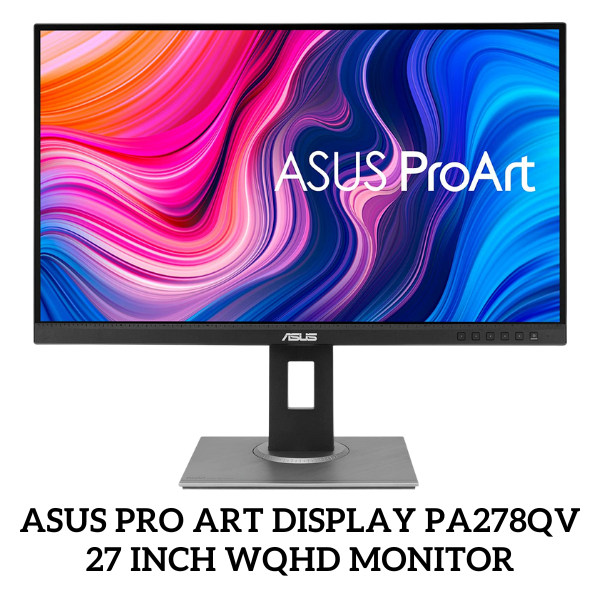
Key Specifications
- Resolution: 2560 x 1440 (QHD)
- Panel: 27″ IPS
- Color Gamut: 100% sRGB, 100% Rec. 709
- Color Accuracy: Calman Verified, Factory pre-calibrated to ΔE < 2
- Connectivity: DisplayPort 1.2, Mini DisplayPort, HDMI 1.4, Dual-link DVI-D, USB 3.0 Hub, Earphone Jack
- Ergonomics: Full adjustability (Height, Pivot, Swivel, Tilt)
Objective Analysis
The PA278QV is an excellent choice for graphic designers, photographers, and content creators working primarily within the sRGB and Rec. 709 color spaces (the standard for web and HD video). The QHD resolution on a 27-inch screen provides a sharp, detailed image without demanding excessive GPU power. Its strength is its reliability and verification; the Calman Verified seal provides confidence in its color performance. The extensive connectivity, including legacy ports like DVI-D, makes it a versatile option for various setups. However, professionals requiring wider gamuts like Adobe RGB will need to consider more advanced models.
2. SAMSUNG S27R650FDN 27-inch IPS Monitor
The Samsung S27R650FDN is better classified as a high-quality business and general-use monitor rather than a dedicated creative professional display. While it uses an IPS panel, its specifications are aimed more at office productivity.
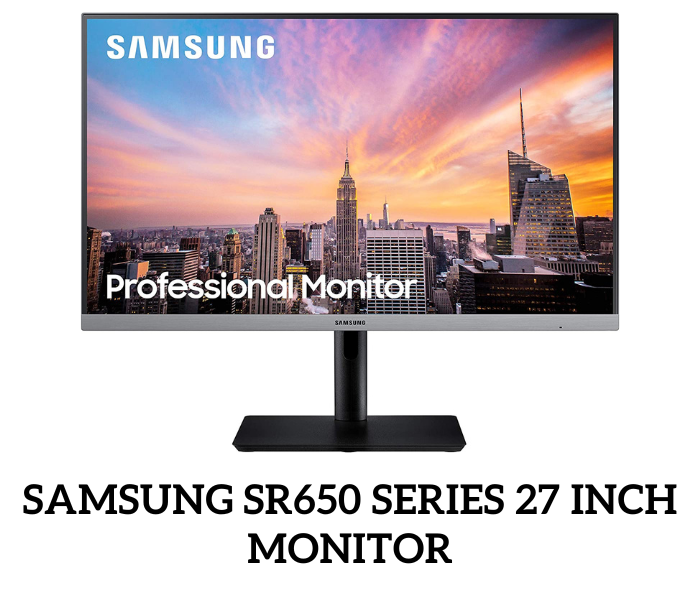
Key Specifications
- Resolution: 1920 x 1080 (Full HD)
- Panel: 27″ IPS
- Color Gamut: Approximately 99% sRGB
- Color Accuracy: Not specified as a key feature
- Connectivity: HDMI, DisplayPort, D-Sub, USB Hub
- Ergonomics: Full adjustability (Height, Pivot, Swivel, Tilt)
Objective Analysis
For a creative professional, the S27R650FDN presents notable limitations. The Full HD resolution on a 27-inch panel results in a lower pixel density, which can make fine details in photos and text appear less sharp. While it features an IPS panel for good viewing angles, Samsung does not market this model with the certified color accuracy (like a low Delta E value) that is a cornerstone of professional photo and video editing monitors. It is a competent office monitor with excellent ergonomics, but it does not meet the stringent requirements for color-critical work.
3. AOC U2790VQ 27″ 4K UHD Frameless Monitor
The AOC U2790VQ was a popular budget-friendly 4K monitor, offering high resolution at an accessible price point. However, This specific model has been largely phased out and replaced by newer iterations.
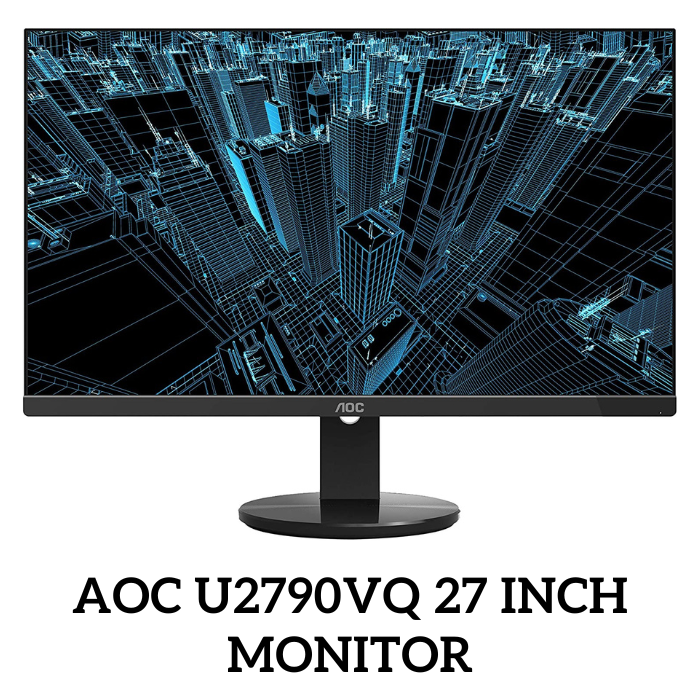
Key Specifications
- Resolution: 3840 x 2160 (4K UHD)
- Panel: 27″ IPS
- Color Gamut: Over 99% sRGB, ~90% NTSC
- Color Accuracy: Not specified with a Delta E value
- Connectivity: HDMI 2.0, DisplayPort 1.2
- Ergonomics: Tilt adjustment only
Objective Analysis
The U2790VQ’s primary draw was its 4K resolution, providing an extremely sharp canvas. Its stated color gamut coverage was good for sRGB-based work. However, its major drawbacks were the lack of guaranteed color accuracy (no factory calibration report) and its minimal ergonomic adjustments (tilt only).
Status Update: This model is generally considered discontinued. A relevant modern alternative from AOC for users seeking a budget-friendly 4K creative monitor would be a model like the AOC U27N3C, which offers a similar 4K IPS panel but adds USB-C connectivity and improved ergonomics.
4. BenQ SW271C 27 Inch 4K Photo and Video Editing Monitor
The BenQ SW271C represents a significant step up into the realm of true professional displays. It is engineered specifically for photographers and videographers who demand the utmost in color fidelity and workflow efficiency.

Key Specifications
- Resolution: 3840 x 2160 (4K UHD)
- Panel: 27″ IPS with Uniformity Technology
- Color Gamut: 99% Adobe RGB, 90% DCI-P3, 100% sRGB
- Color Accuracy: Hardware Calibration Ready, ΔE ≤ 2, Pantone & Calman Validated
- Connectivity: 2x HDMI 2.0, DisplayPort 1.4, USB-C (with 60W Power Delivery), SD Card Reader
- Ergonomics: Full adjustability, includes a shading hood
Objective Analysis
This monitor is a top-tier tool for serious professionals. Its standout feature is its extensive color gamut coverage, particularly the 99% Adobe RGB, making it ideal for print photography. The support for hardware calibration allows for enduring accuracy. BenQ’s Uniformity Technology ensures even brightness and color across the entire screen. The inclusion of a 60W Power Delivery USB-C port, an SD card reader, and a shading hood are all practical features that enhance a creative’s workflow. The SW271C is a direct investment in color precision.
5. ViewSonic VP2468 24-Inch Calibrated Monitor
The ViewSonic VP2468 is a highly regarded monitor for aspiring professionals and enthusiasts who need verified color accuracy on a budget. It focuses on getting the essentials right without the high cost of larger, wider-gamut displays.
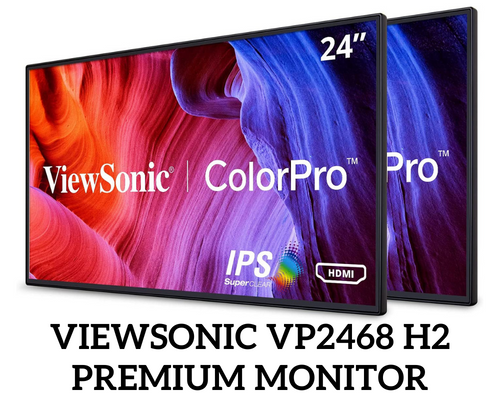
Key Specifications
- Resolution: 1920 x 1080 (Full HD)
- Panel: 24″ IPS
- Color Gamut: 100% sRGB, 100% Rec.709
- Color Accuracy: Factory calibrated to ΔE < 2
- Connectivity: HDMI, DisplayPort In/Out, Mini DisplayPort, USB 3.0 Hub
- Ergonomics: Full adjustability (Height, Pivot, Swivel, Tilt)
Objective Analysis
The VP2468’s strength is its guaranteed sRGB accuracy in an affordable package. The Full HD resolution is perfectly suitable for its 24-inch size, providing a sharp image. A unique and valuable feature at this price point is the DisplayPort Out, which allows for easy daisy-chaining of a second monitor. While it lacks the wide Adobe RGB gamut of the BenQ, it is an exceptional choice for web design, sRGB photography, and HD video editing where accuracy within that standard is paramount. Its full ergonomic stand and four-sided frameless design also make it excellent for multi-monitor setups.
Frequently Asked Questions (FAQ)
Is 99% sRGB sufficient for photo editing?
For photos intended for web display, social media, or general digital use, 99%-100% sRGB coverage is perfectly sufficient and is the professional standard. However, if your work is intended for professional print (magazines, fine art), a monitor with high Adobe RGB coverage (98% or more) is necessary to accurately preview colors that are outside the sRGB gamut.
Which monitor color setting is best for your eyes?
The ideal color temperature depends on your ambient lighting. In a dark room, a warmer, more yellowish temperature (around 5000K) is generally easier on the eyes. In a bright, daylit room, a cooler, bluer temperature (around 6500K) will appear more natural. Many modern monitors and operating systems have features that automatically adjust this, and a quality monitor light bar can help create consistent, non-glare lighting.
Are IPS panels always more color accurate?
IPS panels have the best potential for color accuracy and consistency due to their superior viewing angles and color reproduction capabilities. However, a low-quality, uncalibrated IPS panel can be less accurate than a high-quality, calibrated VA panel. The key is the combination of IPS technology with factory calibration and the ability to perform further hardware calibration.
How often should a color-accurate monitor be calibrated?
For serious professional work, it is recommended to calibrate your monitor at least once a month. All monitors drift in color and brightness over time, and regular calibration with a hardware device (like a colorimeter) ensures that you are always working with a consistent and accurate baseline.
Does a higher refresh rate matter for photo editing?
For static work like photo editing and graphic design, a standard 60Hz or 75Hz refresh rate is perfectly adequate. A higher refresh rate (e.g., 120Hz or more) primarily benefits motion clarity in video editing and gaming. While it can make general use like scrolling feel smoother, it is not a critical feature for color accuracy in photography.

With 15 years of experience as a PC hardware technician, Ben brings a practical, hands-on approach to our PC Components section. He specializes in real-world testing and longevity analysis, explaining how components perform over time. His guides help readers understand the practical side of owning and maintaining a gaming PC.
